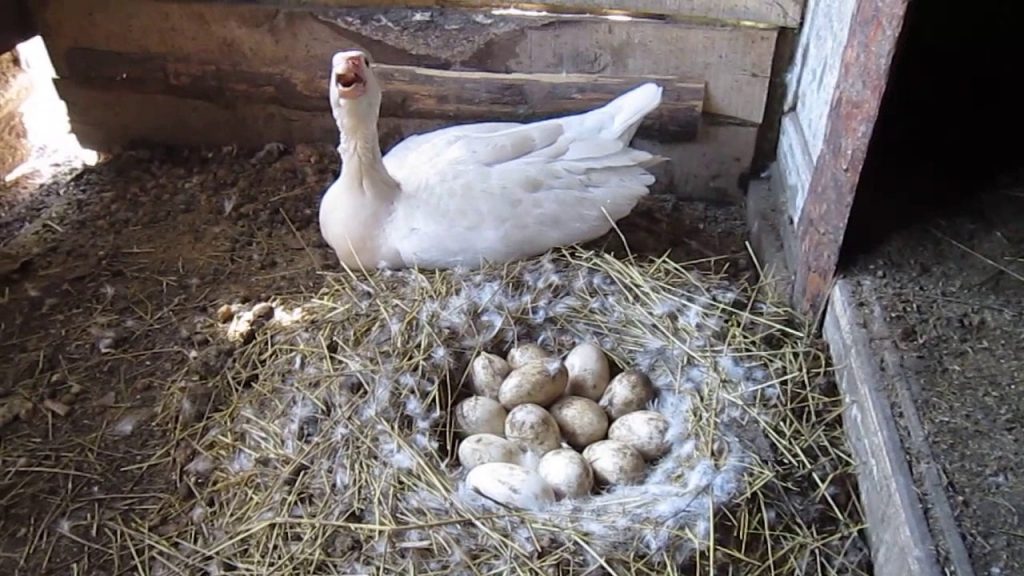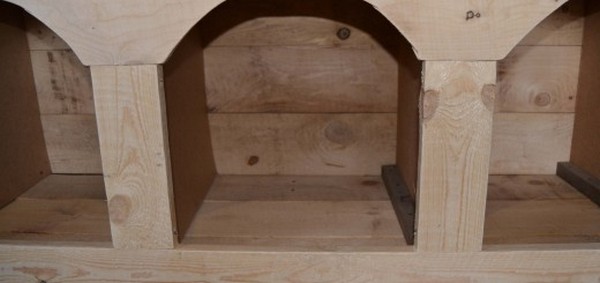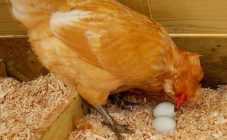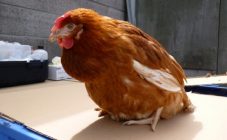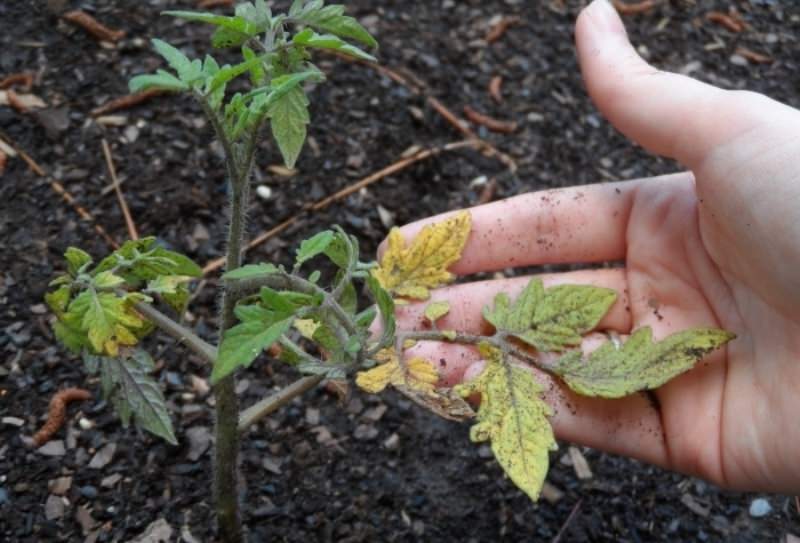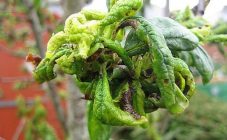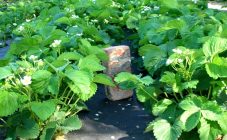Content:
Of the many species of poultry, geese breed more willingly than many, arrange nests on their own, and then incubate a clutch of eggs. It would seem that nothing special is required from the owner, the geese do everything themselves. However, this is not entirely true, breeding goslings has its own characteristics.
Hatching goslings
The last decade of February - the first decade of March is the time when geese lay their eggs. The geese become restless, pluck out their fluff, and line their nests. Clutch is laid in the morning, 1 egg per day. It is very important to ensure warmth in places where chicks will be hatched - the temperature should not be lower than 0 ° С (optimally + 10 ° С).
With the appearance of eggs in the nest, the bird gets up from it only to eat. At this time, the feed mainly consists of barley and oats. It is worth making sure that the path to the trough is as short as possible. While the goose is eating, it is possible to put previously laid eggs in its nest (the optimal amount is up to 15 pieces).
For incubation, only the best eggs are selected - the correct oval shape, without flaws. The shell should be smooth and clean. Usually several geese sit on the nests at once. The candidate is selected within 5 days, no more. It happens that the geese incubating next to them fight without leaving their nests. To prevent this, they arrange solid partitions.
The goose bed must be kept clean. If the nest gets dirty, it will damage the newborn chicks. Geese are not allowed where the eggs hatch.
The host needs to regularly inspect the eggs before the chicks hatch. If unfertilized ones are found, good eggs are taken from this nest and distributed among the rest of the birds, and the goose removed from it is walked for 2-3 weeks. After that, she will begin to rush again.
How long do goslings incubate
It is worth examining the eggs in the light on the 7th day after they are in the nest. It is very easy to determine the worth of each. A dark spot in the center with red threads radiating from it is evidence of the viability of the embryo. If the egg is turned in the light, then the gosling turns too.
In an unfertilized egg, there will be no embryo; even after a week, the white will remain transparent, and the yolk clean. At this time, such "pacifiers" must be taken away and used for food. If the embryo is inside, but has stopped in development, which is easy to identify by the red rings and their scraps inside, you should not eat them. Better to boil and feed to little goslings.
How many days the goslings hatch: 4 weeks on average. Experienced goose breeders recommend washing all eggs 3-4 days before the brood appears. The water is heated to 36 ° C and all the eggs are dipped into it one by one. So it is very easy to quickly separate live eggs from frozen ones. If the egg is alive, then circles should disperse from it along the surface of the water to the beat of the heart of the embryo. There will be no circles on the water from a dead egg. Bathing an egg is only beneficial, as it improves its breathing by flushing the pores.
How many days do goslings hatch
Hatching goslings should occur from the blunt end of the egg on days 27-28. It is better to follow this process closely, helping weak chicks to get rid of the shell. How to help the goslings to hatch: the shell fragments are removed immediately, and the chicks are taken only after they are completely dry. Watching goslings hatch is very interesting, as is watching newborns.
Then they are transferred to a warm place where there is a safe cage or box (the paw should not fall through), and constant access of fresh air.
Often inexperienced housewives ask if the goose has been sitting on eggs for 35 days, what to do? There is only one conclusion: it means that the eggs are spoiled. This could have happened for various reasons, the difference between the reasons is not fundamental. The goose is removed from the nest and walked around, and the spoiled eggs are thrown away. This must be done.
The goose brought out the goslings, what to do next
As soon as the eggs hatch under all the hens, it is necessary to collect all the chicks and distribute them evenly among the geese. Usually those goslings that hatch last are physically weaker than the rest. They pay attention to this, sending those who are weaker to the calmest hen. Castling is carried out with the onset of darkness, when new goslings are no longer born into the world, so that all chicks are under the wings of their mothers.
Goslings hatched, what to do next
With natural incubation, artificial heating is not needed in the place where the chicks are located. If this breed belongs to a non-hatching one, then another hen is planted on the nest - a chicken or a turkey. A chicken can hatch up to 7 goose eggs, and a turkey can hatch up to 13 pieces.
In the first 3 days in the poultry house, a temperature of at least 28 ° C is needed, with each subsequent day it can be gradually lowered by 2-3 degrees. After a week, the optimal mode will be + 25 ° C. By the 16th day, you can lower it to + 22 ° C. A clean, warm bedding is just as important. It will protect goslings from drafts and keep them warm. When the goslings have hatched, what is clear is to provide optimal conditions for growth.
The required temperature regime is monitored with a thermometer and maintained by a 300 W fluorescent lamp. Place the heat source high to avoid the risk of harming the chicks. If the weather outside is cold, then the lamp is not turned off at all. The house should be ventilated daily so that excess moisture can evaporate, and also carry out the necessary cleaning before and after the goose begins to hatch.
Feeding in the first three days consists of fermented milk products, boiled eggs, finely chopped root crops, and wholemeal flour. A mixture of barley, corn and oat flour soaked in milk works well. From 3 days you can give grated carrots, as well as chopped nettles and alfalfa. On the 5th day, a little sand, small pebbles are added to the feeders. There should always be a drinker nearby. As soon as the weather permits, the kids should be sent for a walk in the pasture (aged 2 days and older).
Useful Tips
It's nice that geese rarely get sick. This is explained by the wide variety of their diet. On natural pastures, they are able to find everything they need for a complete menu. However, the breeder must monitor the diet and feed the mother geese with food supplemented with various vitamin and mineral complexes. If we compare geese with ducks, then it is important to take care of the availability of a reservoir for swimming, which even chicks cannot do without.
Proper preparation of the nests is essential for the success of geese breeding. A month before the expected planting of hens, you need to start preparing places.One is never enough, several nests are needed so that each hen must have a choice. Goose comfort is very important. If she does not feel it, she will be nervous and will not hatch the eggs laid under her.
Since there is usually not much space in the goose nest, partitions are erected between individual nests to provide rest for the brood hens. All kinds of materials are used for these purposes, for example, old car tires, containers made of wood or plastic, old furniture, fiberboard, etc. Fresh straw is used for insulation.
The nest level should not be higher than the house floor. The mat is placed on the floor or on a thin sheet of foam. It is worth taking care of the absence of drafts and ensuring dryness and warmth. The sun must also fall into the room, so at least one window must be made in the goose-house. There is no need to leave artificial lighting inside at night. Geese should sleep in the most calm and quiet environment.
The entrance to the nest should not be blocked by anything, and the path of the goose to the water and the feeder should be shortened as much as possible. The eggs will be less likely to freeze if the brood hen does not spend a lot of time feeding.
Given the long period of incubation of goose eggs, if possible, a reservoir (trough or bath) is installed in the house itself or at the entrance to it, where the birds can, if desired, go to swim. The condition is extremely important, since a wet feather moisturizes the eggs, preventing them from drying out. It is much easier for chicks to hatch from a moist shell.
Not always from the first day the goose raised the goslings, they understand that they need to feed. In this case, you need to tap your finger on the feeder to arouse the younger generation's interest in food. Drinking bowls are best used of a vacuum type, or automatic. The trough should have bumpers to prevent food scattering around. Fish oil, yeast and grass meal should be added to the feed so that the goslings get stronger as quickly as possible. On the first day, the frequency of feeding is 5-7 times, and after a week already 4, after 2 and further - 3 times.
It should be noted that hatching goslings is an interesting process, but not as complicated as it might seem.
